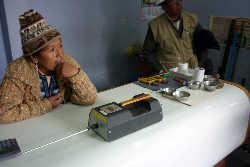Reducing Mercury Pollution from Artisanal and Small-Scale Gold Mining
Learn how EPA's mercury capture system is helping reduce mercury in gold shops.
- New! USAID has recently released Sector Environment Guidelines (SEG) for Mining through their Global Environmental Management Support (GEMS) program. This SEG for artisanal and small-scale mining (ASM) introduces the range of possible impacts, particularly environmental, health, and socio-political, and explains how project managers and others can support prevention and/or mitigation through project design, environmental analyses for initial environmental examinations (IEEs), and during the development of site-specific environmental mitigation and monitoring plans (EMMPs). EPA contributed to the development of these guidelines.
About 20% of the world's gold is produced by the artisanal and small-scale gold mining sector. This sector is also responsible for the largest releases of mercury to the environment of any sector globally. A major source of air pollution from mercury, artisanal and small-scale gold mining releases approximately 400 metric tons of airborne elemental mercury each year.
Located in over 55 countries, small scale gold buying and refining facilities (commonly referred to as “Gold Shops”) are an important part of this production process, and are a major cause of air pollution from mercury.
The burning of mercury-gold amalgam in these Gold Shops can have serious health effects both locally and globally.
- For more information on mercury's health effects, please see the EPA Mercury Portal.
- Learn more about International Actions for Reducing Mercury Emissions and Use.
To reduce airborne mercury emissions from these Gold Shops, EPA and the Argonne National Laboratory (ANL) have partnered to design a low cost, easily constructible technology called the Gold Shop Mercury Capture System (MCS). The MCS was piloted and tested in Amazonian gold producing regions in Brazil and Peru.
Building on a pilot project and workshop held in September 2008, Peru has developed a strategy for the national implementation of this new technology, including workshops and promotion via posters, brochures, and press.
Performance tests indicate the MCS technology can reduce airborne mercury emissions in gold shops by 80 percent, a significant reduction in regions that typically do not have access to any form of effective mercury control technology.
Data collected during site visits in Peru, to Puerto Maldonado, Masuko, and Huepetue in the Amazon, and La Rinconada and Ananea in the high Andes, showed that in shops with the installed MCS technology, mercury vapor concentrations were close to the American Conference of Governmental Industrial Hygienists threshold limit value (ACGIH TLV) for occupational exposure (25 ug/m3). Gold shops that did not have the MCS technology installed had mean ambient mercury vapor concentrations that were five to 20 times higher than those shops that had the mercury control system installed.
Environmental mercury vapor monitoring: La Rinconada, Puno (Peru)

EPA and ANL scientists used Jerome and other Mercury Vapor Analyzers to measure the concentration of airborne mercury released by gold shops located over 17,000 feet above sea level.
The town of La Rinconada (pop: 40,000) in the Andes is one of the highest cities in the world, at 17,020 feet above sea level, and is one of the most productive artisanal gold mining sites in Peru. All of the gold is produced through mercury amalgamation, with open mercury use.
There are an estimated 250-300 gold shops in La Rinconada. EPA and Argonne scientists discovered that average mercury vapor concentrations in open areas (such as the central marketplace) approach the ACGIH TLV for occupational exposure (25 ug/m3). Measurements inside the gold shops were also significantly above the ACGIH TLV.
During a visit to La Rinconada, EPA collected data to assess efficiency of the MCS technology in low temperature and high altitude settings so that this technology can improve air quality in La Rinconada.
